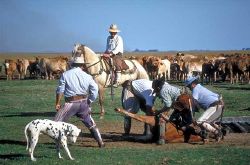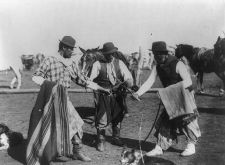Difference between revisions of "Gaucho" - New World Encyclopedia
m |
|||
| Line 1: | Line 1: | ||
{{started}}{{Claimed}}{{started}} | {{started}}{{Claimed}}{{started}} | ||
| − | [[Image:Yerra en Corrientes.jpg|thumb|right|Gauchos taming horses in [[Corrientes Province]], [[Argentina]].]] | + | [[Image:Yerra en Corrientes.jpg|thumb|right|250px|Gauchos taming horses in [[Corrientes Province]], [[Argentina]].]] |
'''Gaucho''' (''gaúcho'' in [[Portuguese language|Portuguese]]) is a term commonly used to describe the nomadic and colorful horsemen and cowhands of the [[South America]]n [[pampas]], [[chaco]]s or [[Patagonia]]n [[pampa|grasslands]], found principally in parts of [[Argentina]], [[Uruguay]], [[Magallanes Region]] in [[Chile]] and the state of [[Rio Grande do Sul]] in southern [[Brazil]]. | '''Gaucho''' (''gaúcho'' in [[Portuguese language|Portuguese]]) is a term commonly used to describe the nomadic and colorful horsemen and cowhands of the [[South America]]n [[pampas]], [[chaco]]s or [[Patagonia]]n [[pampa|grasslands]], found principally in parts of [[Argentina]], [[Uruguay]], [[Magallanes Region]] in [[Chile]] and the state of [[Rio Grande do Sul]] in southern [[Brazil]]. | ||
| Line 12: | Line 12: | ||
==History== | ==History== | ||
| − | [[Image:GauchosvonALE.jpg|thumb|Dramatization of a fight between gauchos]] | + | [[Image:GauchosvonALE.jpg|thumb|225px|Dramatization of a fight between gauchos]] |
Gauchos were generally nomadic and lived on the ''[[pampas]]'', the plain that extends north from [[Patagonia]], bounded on the west by the [[Andes]] and extending as far north as the Brazilian state of [[Rio Grande do Sul]]. Most gauchos were either ''criollo'' (South Americans of [[Spain|Spanish]] ancestry) or ''mestizo'' (of mixed Spanish and [[Indigenous Peoples of the Americas|Native American]] blood), but the term applies equally to people of other [[Europe]]an, [[Africa]]n, or mixed ancestry (see bottom of next paragraph). | Gauchos were generally nomadic and lived on the ''[[pampas]]'', the plain that extends north from [[Patagonia]], bounded on the west by the [[Andes]] and extending as far north as the Brazilian state of [[Rio Grande do Sul]]. Most gauchos were either ''criollo'' (South Americans of [[Spain|Spanish]] ancestry) or ''mestizo'' (of mixed Spanish and [[Indigenous Peoples of the Americas|Native American]] blood), but the term applies equally to people of other [[Europe]]an, [[Africa]]n, or mixed ancestry (see bottom of next paragraph). | ||
| Line 32: | Line 32: | ||
== Modern influences == | == Modern influences == | ||
| − | [[Image:Gauchos.jpg|thumb|Touristic gauchos show]] | + | [[Image:Gauchos.jpg|thumb|250px|Touristic gauchos show]] |
The style of dress associated with Gauchos has filtered into fashion in the [[United States]] . In particular, many manufacturers produce "gaucho pants", similar in appearance to [[capri pants]] but with flared legs. These pants, in their sturdier, original form, are called [[bombachas]] in the [[pampas]], and are dressed with boots and a belt called [[guaiaca]]. | The style of dress associated with Gauchos has filtered into fashion in the [[United States]] . In particular, many manufacturers produce "gaucho pants", similar in appearance to [[capri pants]] but with flared legs. These pants, in their sturdier, original form, are called [[bombachas]] in the [[pampas]], and are dressed with boots and a belt called [[guaiaca]]. | ||
Revision as of 22:59, 20 July 2007

Gaucho (gaúcho in Portuguese) is a term commonly used to describe the nomadic and colorful horsemen and cowhands of the South American pampas, chacos or Patagonian grasslands, found principally in parts of Argentina, Uruguay, Magallanes Region in Chile and the state of Rio Grande do Sul in southern Brazil.
They flourished from the mid-eighteenth to the mid-nineteenth century and today remain popular folk heroes.
Origins
The word gaucho could be described as a loose equivalent to the North American "cowboy". Like the North American word cowboy, Venezuelan or Colombian llanero, or Chilean huaso, or the Mexican vaquero, the term often connotes the 19th century more than the present day; then gauchos made up the majority of the rural pampas population, herding cattle and practicing agriculture as their main economic activities.
There are several conflicting hypotheses of the origin of the term. It may derive from the Quechua huachu (orphan, vagabond) or from the Arabic chaucho (a type of whip used in herding animals). Other hypotheses abound. The first recorded uses of the term date from around the time of Argentine independence in 1816.
History
Gauchos were generally nomadic and lived on the pampas, the plain that extends north from Patagonia, bounded on the west by the Andes and extending as far north as the Brazilian state of Rio Grande do Sul. Most gauchos were either criollo (South Americans of Spanish ancestry) or mestizo (of mixed Spanish and Native American blood), but the term applies equally to people of other European, African, or mixed ancestry (see bottom of next paragraph).
The gaucho plays an important symbolic role in the nationalisms of this region, especially that of Argentina and Uruguay. The epic poem Martín Fierro by José Hernández used the gaucho as a symbol of Argentine national tradition, as opposed to Europeanizing tendencies and as a symbol against corruption. Martín Fierro, hero of the poem, is drafted into the Argentine military for a border war, deserts, and becomes an outlaw and fugitive. The image of the free gaucho is often contrasted to the slaves who worked the northern Brazilian lands. Further literary descriptions can be found in Ricardo Güiraldes' Don Segundo Sombra and Los gauchos judíos, by Alberto Gerchunoff, on the adaptation of Jewish immigrants to rural life in Argentina.
In the early 19th century the gauchos were the mainstay of the armies of the Río de la Plata region, which first had thrown off the Spanish colonial regime and had then engaged in decades-long internal struggles between rival caudillos (provincial military leaders). An unruly group of horsemen called the montonera fought in these wars, usually under the federalist caudillos of the provinces outside of Buenos Aires.
The Gaucho way
Like the North American cowboy, gauchos are generally reputed to be strong, honest, silent types, but proud, and capable of violence when provoked. There is, perhaps, more of an air of melancholy about the classic gaucho than the classic cowboy.
Also like the cowboy, the gauchos were great horsemen. Typically, a gaucho's horse constituted most of what he owned in the world. During the wars of the 19th century in the Southern Cone, the cavalries on all sides were composed almost entirely of gauchos.
The gaucho diet was composed almost entirely of beef while on the range, supplemented by yerba mate, an herbal tea-like drink rich in caffeine and nutrients. The drink remains popular in Argentina and Uruguay today. Argentine cooking draws influence from the simple but delicious recipes used in gaucho meals.
Gauchos dressed quite distinctly from North American cowboys, and used boleadoras (three leather bound rocks tied together with approximately three feet long leather straps) in addition to the familiar "North American" lariat tor riata. The typical gaucho outfit would include a poncho (which doubled as saddle blanket and also as sleeping gear), a facón (large knife), a rebenque (whip), and loose-fitting trousers called bombachas, belted with a tirador, or a chiripá, a piece of cloth used in the fashion—but not the function—of a diaper. Several of these items were British imports into the area; for example, bombachas were originally made in Turkey. In the wintertime, gauchos wore heavy wool ponchos to protect against the cold.
End of an era
By the end of the eighteenth century, private owners had acquired the half-wild livestock on the Pampas and hired the gauchos as skilled animal handlers. By the later nineteenth century the Pampas had been fenced into huge estancias (estates), and the old pastoral economy had given way to more intensive use of the land. Purebred animals replaced the scrub herds and alfalfa was grown to feed them. The once free-spirited gaucho thus became a farmhand or peon.
Modern influences
The style of dress associated with Gauchos has filtered into fashion in the United States . In particular, many manufacturers produce "gaucho pants", similar in appearance to capri pants but with flared legs. These pants, in their sturdier, original form, are called bombachas in the pampas, and are dressed with boots and a belt called guaiaca.
Also, the traditional poncho (a simple garment designed to keep the body warm) has been upgraded in current fashion as well. The mascot and sports teams of the University of California, Santa Barbara also borrow the term "Gaucho." Texas Tech's Masked Rider even wears a "gaucho hat."
Gaucho is also the common denomination of the current inhabitants of the Brazilian State of Rio Grande do Sul. An example is the Brazilian soccer player Ronaldinho, nicknamed by some as Ronaldinho Gaúcho, as he was born in that State. The term is also used to identify some groups of people who live in other states of the southern half of Brazil, Uruguay and northern Argentina. For those people evoking this denomination usually has the purpose of expressing the pride one has for its origins as immigrants to untouched lands and for the hard-working nature it represents. Gauchito (a boy in the Argentine colors and a gaucho hat) was the mascot for the 1978 FIFA World Cup.
See also
- Hacienda system
- Literatura Gauchesca
- Rebenque, the gaucho riding whip
- The Taba Game
- Estancias
- Pato
- Florencio Molina Campos
- Gauchito Gil
ReferencesISBN links support NWE through referral fees
Britannica DVD, 2004: Ultimate Reference Suite Encyclopedia. Brecon (UK): Bvg-Airflo Plc, 2003 DVD. ISBN 1593390858
- Confederacion Gaucha Argentina
- Folklore del Norte Argentino (in Spanish)
- Movimento Tradionalista Gaúcho (in Portuguese)
- Página do Gaúcho (in Portuguese)
- Aldo Sessas - Gauchos
Credits
New World Encyclopedia writers and editors rewrote and completed the Wikipedia article in accordance with New World Encyclopedia standards. This article abides by terms of the Creative Commons CC-by-sa 3.0 License (CC-by-sa), which may be used and disseminated with proper attribution. Credit is due under the terms of this license that can reference both the New World Encyclopedia contributors and the selfless volunteer contributors of the Wikimedia Foundation. To cite this article click here for a list of acceptable citing formats.The history of earlier contributions by wikipedians is accessible to researchers here:
The history of this article since it was imported to New World Encyclopedia:
Note: Some restrictions may apply to use of individual images which are separately licensed.
